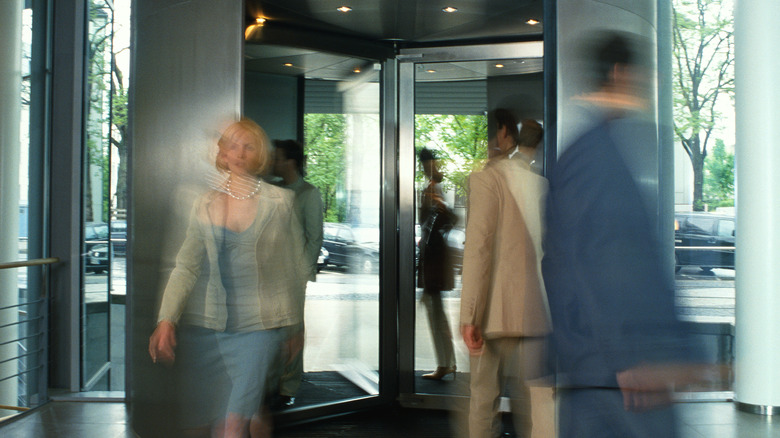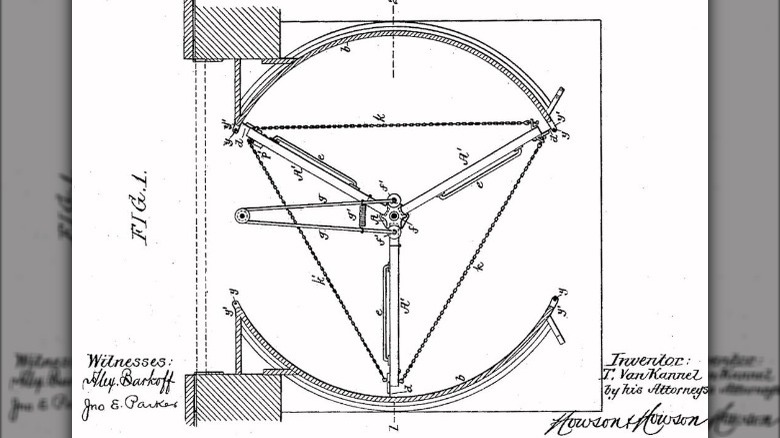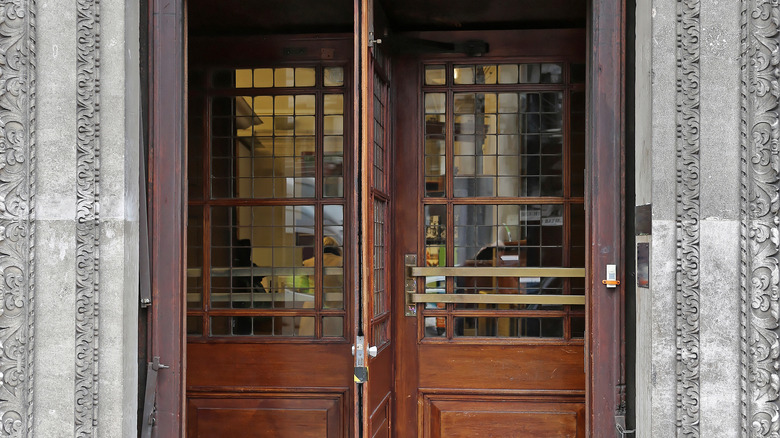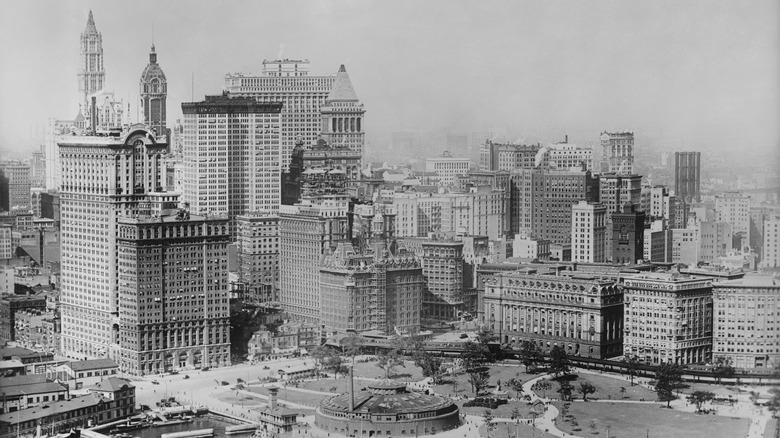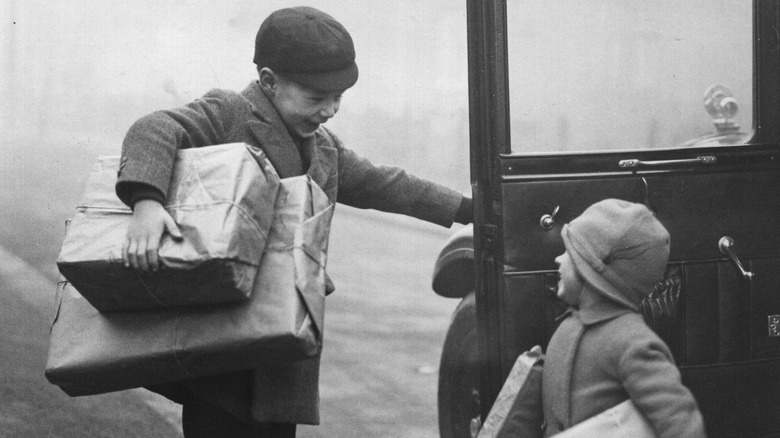Who Invented The Revolving Door?
Going through a revolving door is an event. Any hotel lobby or public building instantly seems more important and imposing with this big spinning turbine of metal and glass. The door constantly rotates as people move in and out of the building, usually to and from a busy city street, and picking the right time to jump in can feel like a leap of faith. But as futuristic as this design may seem, it's more than a century old.
The revolving door was invented as a solution to a remarkably mundane problem: drafts and noise. Architects loved it as a lavish entrance to their skyscrapers — which also solved an air pressure problem — and patrons loved to spin around in it like a carousel (via the Pennsylvania Center for the Book). The wide appeal of the invention proved it would persist even to the modern day, where a new rumor has taken hold alleging that the creator hated opening doors for women and was spanked in front of dozens of mothers and daughters.
The revolving door's inventor was sick of the cold
In the 1880s, Theophilus Van Kannel was working the front desk in a Philadelphia lobby when he decided he'd had enough of normal doors (via the Pennsylvania Center for the Book). Winter days were the worst time to work the desk, as each time someone came in or left the building he'd be blasted with cold air and assaulted with the noise of the front doors slamming shut. "Every person passing through," said Van Kannel, "first brings a chilling gust of wind with its snow, rain or dust, including the noise of the street; then comes the unwelcome bang!"
By 1888, Van Kannel had decided to take matters into his own hands. He designed a "New Revolving Storm Door" as a solution, and got the idea patented that August. His new revolving door would actually take shape as three-to-four doors rotating on a single pivot, which ensured that two doors would always maintain a seal between the cold outside air and the warmer air inside. This also had the effect of minimizing noise, both from the city street and from the constant slamming of doors.
Van Kannel's doors catch on
According to the Pennsylvania Center for the Book, Theophilus Van Kannel's design for his "New Revolving Storm Door" began popping up all over Philadelphia stores and restaurants as soon as he patented his invention. By the end of 1888, Van Kannel's doors received high praise from the manager of Thackray's Restaurant, who applauded the way their new doors kept out strong wind and shielded patrons from the noise of the city. Van Kennel even earned an accolade from Philadelphia's Franklin Institute: the John Scott Legacy Medal for useful inventions. More than a century later, he was inducted into the National Inventors Hall of Fame for his patented revolving door.
It turned out that plenty of businesspeople were just as fed up with bursts of cold air and slamming doors as Van Kannel was, and soon he founded the Storm-Proof Door Company of Philadelphia to service his new clients near and far. As popular as his revolving doors were, though — with some restaurant guests simply spinning around it just for the ride — its utility would soon prove to do more than just keep out wind and noise.
The perfect door for the modern city
With the 20th century looming and urban landscapes changing rapidly, Theophilus Van Kannel's revolving door proved to be a favored addition of architects in big cities. The Pennsylvania Center for the Book notes that a common problem for skyscraper architects at the time was the vacuum created in building lobbies by elevator shafts and stairwells, and the difference in air pressures between outside and inside affected how easily conventional doors could open. Revolving doors solved this problem by preventing the pressure inside from changing too quickly, but it also added an aesthetic element to a building's design by creating a dramatic entrance for patrons walking into a hotel or department store.
It wasn't just architects who loved Van Kannel's design. Filmmakers and studio artists also took his invention for a spin, with Man Ray creating an interactive rotating collage called "Revolving Doors" in 1916, and Charlie Chaplin using the revolving door for a gag in his 1917 movie "The Cure." (The scene is posted on YouTube.) Of course, the name of Van Kannel's invention also entered pop culture as a phrase indicating a rapid change of personnel, as in a "revolving door of leadership," according to Merriam-Webster Dictionary.
Did Van Kannel really hate holding doors open for women?
Over the next century, as Theophilus Van Kannel's revolving door became a common sight in cities around the world, a strange rumor began to grow about the inventor. According to Snopes, the rumor cropped up online in the 2000s, and put a misogynistic spin on Van Kannel's invention of his famous revolving door. According to claims made in publications as mainstream as Slate, these doors were invented simply became Van Kannel hated chivalry. Opening a door for another person — especially a woman — was apparently out of the question for him. As the rumor grew, it began to incorporate elements like a purported social phobia and the idea that Van Kannel had no family. The original post at The Nonist even claimed the inventor was punished as a child for refusing to open doors for women, and was "administered a savage bare-bottomed spanking, during a salon in the family's drawing room, in full and explicit view of 37 local mothers and daughters."
But is any of it true? Snopes says no. That original Nonist article turned out to be a kind of satire, and one that only cited a single source (which doesn't back up any tales of spankings or misogyny). Snopes did their own archival research and found no evidence to support the rumor. In fact, the inventor appeared to be quite amenable to Victorian social mores. The truth seems to be that Van Kannel simply hated the chilling air of an open door.
The revolving door today
According to the National Inventors Hall of Fame, Theophilus Van Kannel founded his own company by the end of the 1880s: the Van Kannel Revolving Door Company. It was bought by International Steel in 1907, and operates today as the International Revolving Door Company.
Though Van Kannel's invention was popular in commercial spaces, he worked hard to market his revolving doors to homeowners. The Pennsylvania Center for the Book says that Van Kannel prepared brochures and talks to convince people to install his quiet spinning doors in their foyers. Perhaps due to the cost of such a project, people weren't interested.
However, the revolving door did continue to grow and evolve, with changes to production materials — steel instead of wood, a decision made after Van Kannel sold the company — and the addition of modern metal detectors and other security features. Some buildings even use the near-constant rotation of revolving doors as an energy-generating turbine.
